Boat Buffer
You don't know what you don't know!
Finding the best boat buffer will be an oversimplified quest for most of you. Experience has shown that most people think that polishing car paint is essentially the same as polishing a boat.
While the fact does remain that many of the same tools and products do indeed work across the spectrum of car and boat polishing, understanding the differences between gel coat and the different buffers will go far to avoid disappointment and achieving optimum results.
Follow along with this comprehensive review and see if you don't walk away with answers to questions you don't even know to ask.
Boat Polishers: Question and Answers
Q. What is the difference between a boat buffer and a boat polisher?
A. Nothing. The term polisher and buffer are interchangeable since the industry does not have any standardized label. Each person or each company can use either term when describing these "tools".
Q.-I heard that car paint and gel coat is really the same when it comes to polishing and waxing.
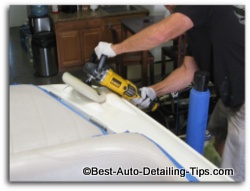
A.-The fact is that while you could virtually use the same of everything to polish a boat as you would to polish your car, the real difference will be more about results.
(Many people will co-mingle fiberglass and gel coat when referring to their boat. While fiberglass is used to make boat hulls and decks, fiberglass actually refers to the fiberglass cloth used in the gel coat process. Gel coat is the top layer and this is what you would be working on when buffing any boat. Yes, boats can be painted, but this is the very rare exception to the rule.
I will also use the terms buffer and polisher interchangeably as there is no official difference, and no standard rule in the industry as to which is which. Polishers and buffers mean the same thing in the detailing world regardless of working on cars or boats.
Gel coat is very porous and very durable. Gel coat has no protective layer to it like the clear coat on car paint and therefore oxidizes easily. You may not have noticed but the majority of boats are white. One of the reasons is that white gel coat does not reveal the oxidation like darker colors of gel coat would.
Just know that while choosing a professional grade boat buffer is critical, it is also critical that you understand that polishing on gel coat is very different than polishing on car paint. And the real difference is the amount of work it requires when polishing on gel coat to get the results you are after. This is all due to gel coat being such a strong and durable material.
Q.- What is the critical point I need in understanding the difference between car paint and gel coat?
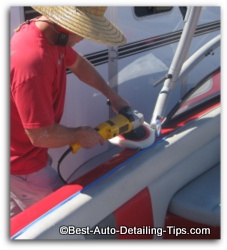
A.- If you have a boat that is in pristine condition, it will matter not what kind of boat polisher or product you use to polish your boat since your boat is in excellent condition and no level of oxidation exists. But most people go looking for the best boat buffer and polish due to some level of oxidation, and this is the point where selecting the right boat polisher and polish will make or break your world. Unless you have aggressive enough tools and products, your boat oxidation removal will be minimal at best. To truly perform oxidation removal and gel coat restoration, traditional random orbital or DA car polishers will be the equivalent of bringing a BB gun to a gun fight!
Traditional dual-action (DA) or random orbital car polishers just aren't capable of producing the kind of friction required to produce the results you will want on your boat.
Yes these type of buffers are super safe and easy to use, but their limitation is very significant in the form of working power needed to restore gel coat.
Q.- So what kind of boat buffer do I need to do the job?
A. - A high-speed buffer; also referred to as a rotary buffer. These buffers are buried in bad press mostly due to inexperienced and/or misinformed guys repeating bad information. The fact remains that gel coat requires the friction and heat that can only be produced through these high-speed polishers. Dual-action (DA) or random orbital polishers simply cannot produce the necessary heat and friction required to remove oxidation from gel coat...unless of course you are willing to spend an eternity using the wrong tool to achieve desired results.
Q.- I heard that high-speed buffers should never be used as they leave swirl marks and can damage paint?
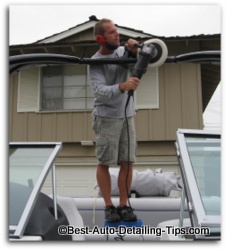
A.- We must remember a few things here; first, we are talking gel coat. And second, gel coat is not car paint. The good news is that gel coat is very tough and can withstand far more pressure, heat, and friction than car paint. This means good news to any beginner looking to polish their own boat, but at the same time this is exactly why a high-speed polisher is needed to achieve any discernible or lasting results. I have seen many do-it-yourselfers try and save a buck by spending the entire weekend with their fathers old-school orbital polisher, or the dual-action (DA) car polishers that have become so popular these days, only to have the oxidation re-appear a few weeks later due to their inexperience and ignorance of what they are doing, and what they are working on.
You may take satisfaction in polishing on your boat with a very "safe" dual-action car polisher, and feel a sense of accomplishment until you catch the area you just polished in the right lighting only to realize that that very safe dual-action polisher hasn't really removed the oxidation from your boat.
Q.- Now that I know a rotary or high-speed polisher is the best boat buffer, what are the best high-speed buffers I should consider for polishing my boat?
A.- Glad you asked as there are really only 2 buffers any experienced professional would recommend. You will find these below.
I have used both of them extensively and I don't have a preference as they are both quality tools. Any real difference will be in the nuances and as a beginner, you would not be capable of appreciating these.
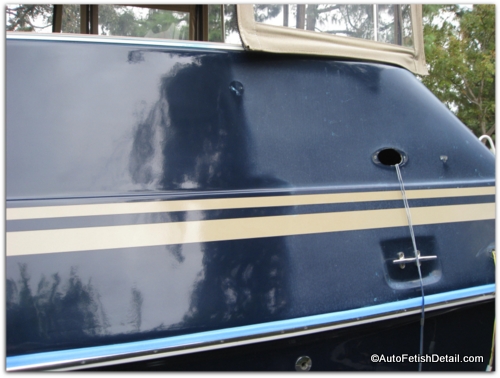 Here I am using my boat buffer (DeWalt) and my CSI Rip Cut to remove the oxidation from this boat. I am working This is the side of an electric boat that is made using the same methods as any traditional boat. You can see the before and after in this picture. I used a very aggressive polish along with a high speed buffer to achieve these types of results.
Here I am using my boat buffer (DeWalt) and my CSI Rip Cut to remove the oxidation from this boat. I am working This is the side of an electric boat that is made using the same methods as any traditional boat. You can see the before and after in this picture. I used a very aggressive polish along with a high speed buffer to achieve these types of results.
Boat Polisher Reviews
Darren's Tips: You could spend days researching the endless reviews about the best boat polishers, compounds, and polishing pads only to find yourself more confused, frustrated, and still no closer to getting what you really want....
a shiny, glossy, and protected boat!
Best Boat Polish
I will actually begin with my recommendations of a gelcoat compound since I have learned that the right compound is just as important as choosing the right boat buffer.
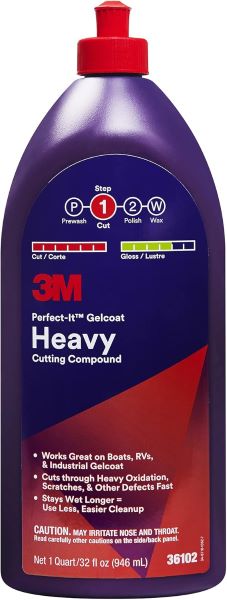
3M Heavy Duty Gelcoat Compound on Amazon
You will see that my first pick is a heavy duty compound. As a beginner this will likely scare you as you probabaly think your boat is "not that bad".
And since your boat may not be that bad, why would you want to start with a heavy duty compound?
Because I know that any degree of oxidation will require more work than any beginner can imagine. Which is why I always recommend you start with heavy duty -which is in many ways the complete opposite of what I teach when it comes to car paint.
Yes, this will still create plenty of shine, but it will also help you achieve the results you want far quicker than is you default to a mild compound or polish.
Darren's Tip: I have yet to see any person (other than a professional) buff out their boat in a single day. For this reason I say start with this, then if you are not satisfied with the shine you can achieve with the heavy duty compound, then you can go back over your boat with a fine grade of polish.
Best Boat Wax

Something you need to realize is just how easily gel coat/fiberglass will oxidize. For this reason, consistent application of a quality marine grade wax will be necessary.
After you have taken the time to pick the best boat buffer and compound your boat to remove all the oxidation, you will need regular applications of a quality marine wax.
And when I say regular applications, I mean as in every couple of months. You cannot over-wax your boat and there is no such thing as wax build-up, so keep that wax coming!
Makita Boat Buffer
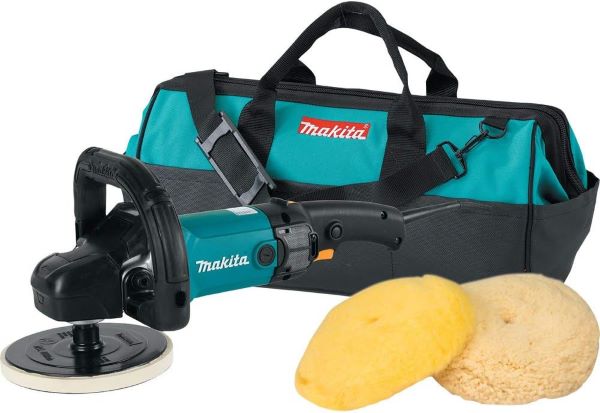
- Professional grade buffer
- Excellent piece of equipment with a very reasonable price
- Soft start trigger that allows you to ease into each moment of polishing
- Pretty much the same features as any of the boat polishers on this page
- This Makita has a higher RPM setting than the other two buffers below (the Makita can be dialed up to 3200 RPM's but I have never used any more than 2,000 RPM's for any kind of polishing whether this be on cars or boats. As a rule, I polish at speeds from 1200 to 1800 RPM's and dial the buffer down to 600 RPM for what is now called jeweling in the industry)
DeWalt Boat Buffer
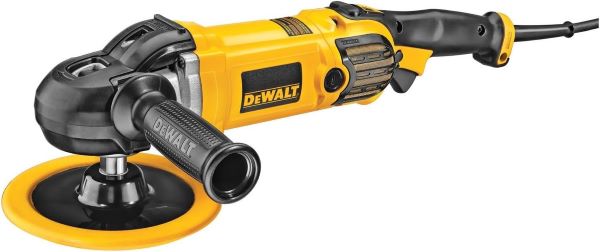
- One of my personal favorites.
- New slower operating speeds means a safer learning curve for any newbie.
- Slower start speed not only makes this polisher safer for beginners, but allows for what is called finish polishing, or "jeweling".
- Will handle any job you throw at it; boat, car, RV.
- A true work-horse!
Darren's Professional Tips
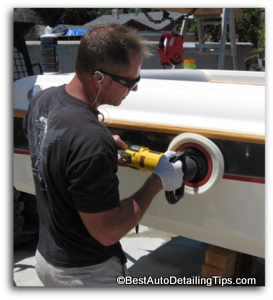
If you're searching for a boat buffer, chances are you're dealing with fiberglass or gel coat oxidation. What many people don't realize is just how stubborn gel coat can be when it comes to polishing.
Yes, you can polish your boat to a decent shine—but unless you remove enough oxidation, that shine won’t last. It will fade quickly because the oxidation wasn’t fully eliminated.
Think of oxidation like a cancer: if you don’t get rid of it completely, it will return. And the more that’s left behind, the sooner it reappears.
Common Polishing Mistakes
Most DIY boat owners use tools and products that are far too mild. Unlike car paint, gel coat is incredibly tough and can handle much more:
- More pressure
- More friction
- Higher heat
Boats require aggressive polishing to produce results that last.
Choosing a Boat Buffer
Any of the recommended buffers above will give excellent results:
- Suitable for both cars and boats
- Ideal for beginners and experienced users alike
- Soft-start trigger adds a layer of safety for new users
Polishing Best Practices
- Use a wool pad and set your buffer to 1200 RPM
- Beginners should start slow and increase speed as confidence grows
- Apply compound to the center of the pad—about a half-dollar size
- Keep the pad flat on the surface before turning the buffer on
- Work in 2' x 2' sections at a time
- Reapply compound as needed
- Use a cleaning spur to refresh the pad—ideally every second application
Darren’s Tips:
- Expect a learning curve. Whether it’s your first time or you’re switching products, every polish and compound behaves differently.
- Gel coat is not car paint. It needs more product, more pressure, and more speed to get real results. Don’t be afraid to get aggressive—your boat can take it.
Universal Pad Washer
Darren's Tip: While it is not a true requirement, since I started using this universal pad washer I have grown to love the benefits it offers and question how I managed before these came along.
While they are what I consider an expensive add-on, I also consider it a worthy expense for the basic reason:
"Whether you are polishing a boat or car; it is hard work! Having the best tools, products, and accessories will make the job dramatically easier and better. The right tools and products will literally make the difference between success and failure as well as overall user experience. Do not take this lightly!"
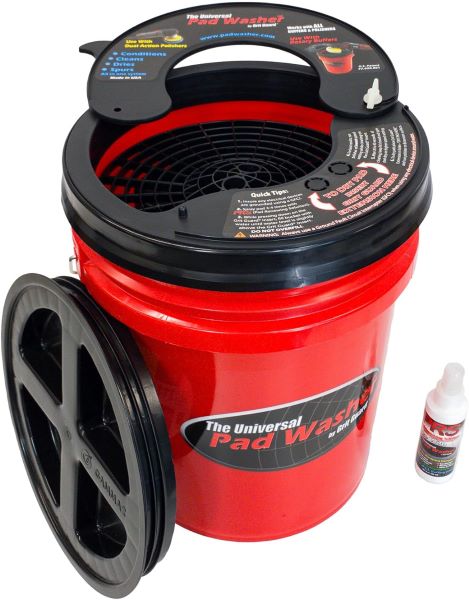
Universal Pad Washer on Amazon
- Wool buffing pads sling lots of wool fibers at the beginning
- This pad washer will help manage this wool fiber mess significantly
- Quicker, easier, and more effective at cleaning your buffing pad than a traditional cleaning spur
- This pad washer can be used with, or without water ( I actually prefer using it without water as this saves me additional steps of using the pad washer by not having to deal with any water)
Boat Buffer and Colored Boats:
Taking your shine to the next level
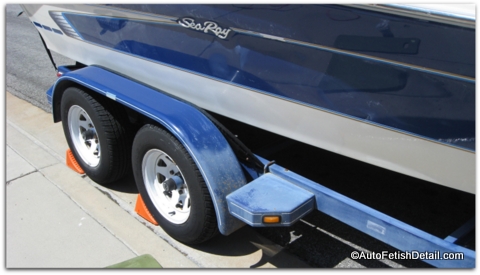 Look closely at the trailer fender and you can see the line of demarcation where I have polished the oxidation from the trailer fender to restore the gloss and shine to this boat trailer. The same compound, pads, and buffer that I used on the boat hull is also what I used on the trailer.
Look closely at the trailer fender and you can see the line of demarcation where I have polished the oxidation from the trailer fender to restore the gloss and shine to this boat trailer. The same compound, pads, and buffer that I used on the boat hull is also what I used on the trailer.If you are polishing a boat that has been made with any type of color to the gelcoat your job will be harder. Any type of color will reveal the oxidation much more when compared to white gelcoat.
This is useful when determining how oxidized your boat is, but it also makes the challenge of polishing your boat to satisfactory levels harder since your results will be more clearly visible —just as your lack of results will be more clearly visible.
Most boats or white for this reason —white gelcoat hides the oxidation, while colored gelcoat reveals oxidation. Every boat in very simple terms will have some degree of oxidation. The moment your boat leaves the "factory", it begins to oxidize.
Regardless of whether your boat is all white or has some color to it, the polishing is the same. What you need to know is that since any type of colored gelcoat is much more revealing, polishing any colored section of gelcoat will require more polishing since the color will reveal the nuances of any oxidation still present or how much more polishing on your part is required to achieve desired results.
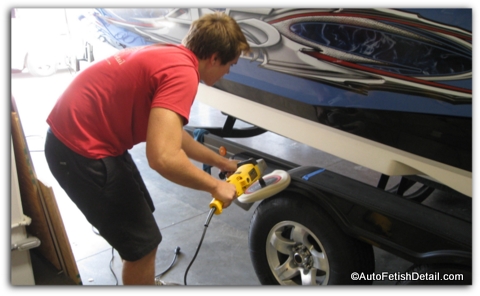 Here is a shot of my son using a rotary polisher with a wool pad for the first time to polish-out the fender on this boat trailer. This was the first buffer he had ever used and he was able to produce desired results using the very products and equipment shown on this page.
Here is a shot of my son using a rotary polisher with a wool pad for the first time to polish-out the fender on this boat trailer. This was the first buffer he had ever used and he was able to produce desired results using the very products and equipment shown on this page.While the combination of a rotary polisher, wool pad, and a heavy duty compound will seem particularly intimidating to any beginner, just know that it is not as scary as it might appear.
This is why I love these boat buffers above that have not only the soft-start trigger, but can be dialed down to a very low 600 RPM operating speed. In the event you have never used a polisher before; 600 RPM's is incredibly low and you will be pleasantly surprised as to how easy it is in using a buffer for the first time.
Any of the buffers and products above will allow you to safely learn how to not only polish in general, but polish your boat specifically.
Wool Pad Cleaning Spur
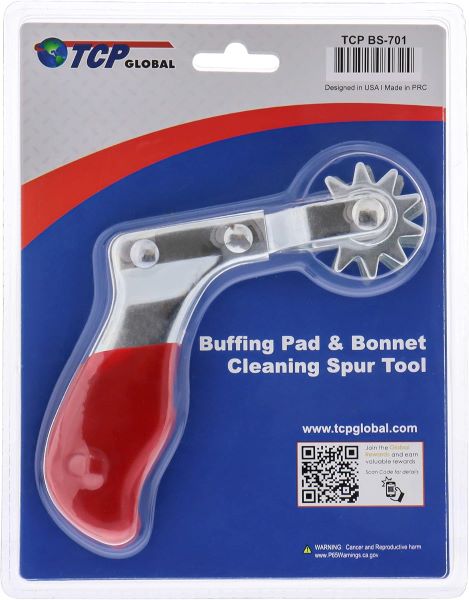
- For use when cleaning wool pads only
- Will keep pad fibers loose and separated
- I hold boat buffer against my leg and turn on while I hold cleaning spur against pad face to break up and release spent compound and gel coat material
- I use to clean my pad while working every other application of compound.
Darren's Tip: Even if you get the pad washer, I still like to use this cleaning tool to "fluff" up the pad fibers after cleaning the pad with the pad washer.
Pay "Boat Buffer" Forward
If you have learned something of value from this page, pay it forward by sharing to your favorite forum or social group.
Speaking from experience; boat polishing or fiberglass restoration is not an easy task even for a trained professional.
But with my recommendations above you will at least have a fighting chance to getting professional results, and not be lead down the wrong path only to add further frustration to an already frustrating proposition!
Sincerely,
Darren Priest
- Home
- Auto Buffer
- This Page
|
|

